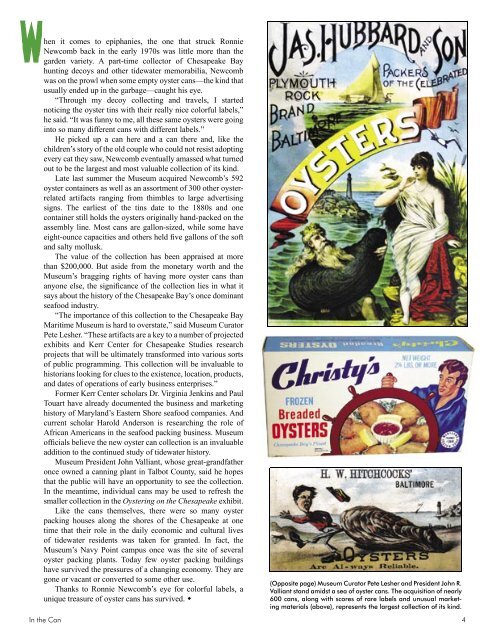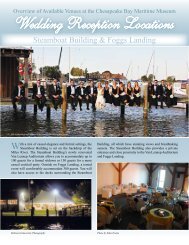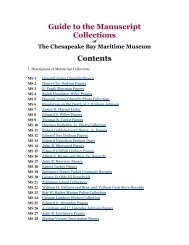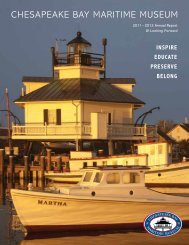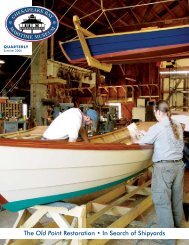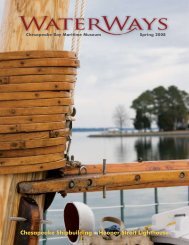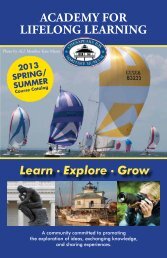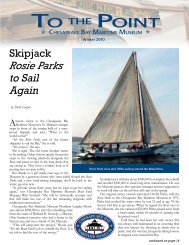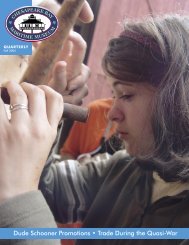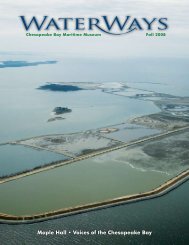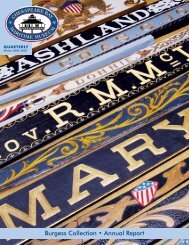Spring 2003 - Chesapeake Bay Maritime Museum
Spring 2003 - Chesapeake Bay Maritime Museum
Spring 2003 - Chesapeake Bay Maritime Museum
Create successful ePaper yourself
Turn your PDF publications into a flip-book with our unique Google optimized e-Paper software.
When it comes to epiphanies, the one that struck Ronnie<br />
Newcomb back in the early 1970s was little more than the<br />
garden variety. A part-time collector of <strong>Chesapeake</strong> <strong>Bay</strong><br />
hunting decoys and other tidewater memorabilia, Newcomb<br />
was on the prowl when some empty oyster cans—the kind that<br />
usually ended up in the garbage—caught his eye.<br />
“Through my decoy collecting and travels, I started<br />
noticing the oyster tins with their really nice colorful labels,”<br />
he said. “It was funny to me, all these same oysters were going<br />
into so many different cans with different labels.”<br />
He picked up a can here and a can there and, like the<br />
children’s story of the old couple who could not resist adopting<br />
every cat they saw, Newcomb eventually amassed what turned<br />
out to be the largest and most valuable collection of its kind.<br />
Late last summer the <strong>Museum</strong> acquired Newcomb’s 592<br />
oyster containers as well as an assortment of 300 other oysterrelated<br />
artifacts ranging from thimbles to large advertising<br />
signs. The earliest of the tins date to the 1880s and one<br />
container still holds the oysters originally hand-packed on the<br />
assembly line. Most cans are gallon-sized, while some have<br />
eight-ounce capacities and others held five gallons of the soft<br />
and salty mollusk.<br />
The value of the collection has been appraised at more<br />
than $200,000. But aside from the monetary worth and the<br />
<strong>Museum</strong>’s bragging rights of having more oyster cans than<br />
anyone else, the significance of the collection lies in what it<br />
says about the history of the <strong>Chesapeake</strong> <strong>Bay</strong>’s once dominant<br />
seafood industry.<br />
“The importance of this collection to the <strong>Chesapeake</strong> <strong>Bay</strong><br />
<strong>Maritime</strong> <strong>Museum</strong> is hard to overstate,” said <strong>Museum</strong> Curator<br />
Pete Lesher. “These artifacts are a key to a number of projected<br />
exhibits and Kerr Center for <strong>Chesapeake</strong> Studies research<br />
projects that will be ultimately transformed into various sorts<br />
of public programming. This collection will be invaluable to<br />
historians looking for clues to the existence, location, products,<br />
and dates of operations of early business enterprises.”<br />
Former Kerr Center scholars Dr. Virginia Jenkins and Paul<br />
Touart have already documented the business and marketing<br />
history of Maryland’s Eastern Shore seafood companies. And<br />
current scholar Harold Anderson is researching the role of<br />
African Americans in the seafood packing business. <strong>Museum</strong><br />
officials believe the new oyster can collection is an invaluable<br />
addition to the continued study of tidewater history.<br />
<strong>Museum</strong> President John Valliant, whose great-grandfather<br />
once owned a canning plant in Talbot County, said he hopes<br />
that the public will have an opportunity to see the collection.<br />
In the meantime, individual cans may be used to refresh the<br />
smaller collection in the Oystering on the <strong>Chesapeake</strong> exhibit.<br />
Like the cans themselves, there were so many oyster<br />
packing houses along the shores of the <strong>Chesapeake</strong> at one<br />
time that their role in the daily economic and cultural lives<br />
of tidewater residents was taken for granted. In fact, the<br />
<strong>Museum</strong>’s Navy Point campus once was the site of several<br />
oyster packing plants. Today few oyster packing buildings<br />
have survived the pressures of a changing economy. They are<br />
gone or vacant or converted to some other use.<br />
Thanks to Ronnie Newcomb’s eye for colorful labels, a<br />
unique treasure of oyster cans has survived. •<br />
(Opposite page) <strong>Museum</strong> Curator Pete Lesher and President John R.<br />
Valliant stand amidst a sea of oyster cans. The acquisition of nearly<br />
600 cans, along with scores of rare labels and unusual marketing<br />
materials (above), represents the largest collection of its kind.<br />
In the Can 4


